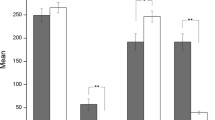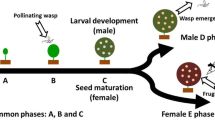Summary
-
1)
Figs (Ficus) and fig-pollination wasps (Agaonidae) are highly coevolved mutualists that depend completely on each other for continued reproduction. However, their reproductive interests are not identical.
-
2)
The natural history of their interaction often permits the direct measurement of total lifetime reproductive success of the wasp and of major components of reproductive success for the fig.
-
3)
Data from 12 monoecious species of New World figs (subgenusUrostigma) and their wasp pollinators (Pegoscapus spp.) indicate that fig fruit size (number of flowers per fruit), wasp size, and the number of foundresses that pollinate and lay eggs in any given fruit interact in complex but systematic ways to affect the reproductive success of both the wasps and the figs.
-
4)
Different aspects of the interaction may work against the reproductive interests of either the wasp or the fig, or often, both. For example, in some species an ‘average’ foundress may only realize 25% of its reproductive potential due to the high average number of foundresses. However, that same crowding slects for more male-biased sex ratios in the wasps that reduce potential fitness gains through pollen dispersal for the fig. Nonetheless, the natural distributions of numbers of foundresses per fruit more clearly reflect the reproductive interests of the figs than of the wasps.
-
5)
Generally, it appears that most of the fig species studied can be arranged along a continuum from those with physically small fruits that produce a relatively low proportion of viable seed butt are very efficient at the production of female wasps to physically large, relatively seed-rich fruits that are relatively inefficient at producing female wasps. The implications of these findings for the coevolution of figs and their wasps are discussed.
Similar content being viewed by others
References
Berg, C. C., Floral differentiation and dioecism inFicus (Moraceae), in: Minisymposium: Figs and Fig Insects, pp. 15–25. Eds F. Kjellberg and G. Valdeyrons. CNRS. Montpellier, France 1984.
Bonacorrso, F., Foraging and reproduction in a Panamanian bat community. Bull. State Mus., Biol. Sci.24 (4) (1979) 359–408.
Bronstein, J. L., Limits to fruit production in a monoecious fig: consequences of an obligate mutualism. Ecology69 (1988a) 207–214.
Bronstein, J. L., Mutualism, antagonism, and the fig-pollinator interaction. Ecology69 (4) (1988b) 1298–1302.
Bulmer, M. G., and Taylor, P. D., Dispersal and the sex ratio. Nature284 (1980) 448–449.
Charnov, E. L., The Theory of Sex Allocation. Princeton University Press, Princeton 1982.
Colwell, R. C., Group selection is implicated in the evolution of female-biased sex ratios. Nature290 (1981) 401–404.
Frank, S. A., A hierarchical view of sex-ratio patterns. Florida Ent.66 (1) (1983) 42–75.
Frank, S. A., The behavior and morphology of the fig waspsPegoscapus assuetus andP. jiminezi: descriptions and suggested behaviors for phylogenetic studies. Psyche91 (1984) 289–307.
Frank, S. A., Hierarchial selection theory and sex ratios. II. On applying the theory, and a test with fig wasps. Evolution39 (1985) 949–964.
Galil, J., and Eisikowitch, D., Studies on mutualistic symbiosis between syconia and sycophilous wasps in monoecious figs. New Phytol.70 (1985) 773–787.
Garwood, N. C., and Horvitz, C. C., Factors limiting fruit and seed production of a temperate shrub,Staphylea trifolia L. (Staphylaceae). Am. J. Bot.72 (3) (1985) 453–466.
Hamilton, W. D., Extraordinary sex ratios. Science156 (1967) 477–488.
Hamilton, W. D., Wingless and fighting males in fig wasps and other insects, in: Reproductive Competition and Sexual Selection in Insects. Eds M. S. Blum and N. A. Blum. Academic Press, New York 1979.
Herre, E. A., Sex ratio adjustment in fig wasps. Science288 (1985) 896–898.
Herre, E. A., Optimality, plasticity, and selective regime in fig wasp sex ratios. Nature329 (1987) 627–629.
Herre, E. A., Leigh, E. G., and Fischer, E. A., Sex allocation in animals, in: The Evolution of Sex and its Consequences. Ed. S. C. Stearns. Birkhäuser, Basel 1987.
Janzen, D. H., How to be a fig. A. Rev. Ecol. Syst.10 (1979a) 13–51.
Janzen, D. H., How many babies do figs pay for babies? Biotropica11 (1979b) 48–50.
Janzen, D. H., How many parents do the wasps from a fig have? Biotropica11 (1979) 127–129.
Kjellberg, F., Gouyon, P. H., Ibrahim, M., Raymond, M., and Valdeyron, G., The stability of the symbiosis between dioecious figs and their pollinators: a study ofFicus carica L. andBlastophaga psenes L. Evolution41 (1987) 693–704.
Milton, K., Windsor, D. M., Morrison, D. W., and Estribi, M. A., Fruiting phenologies of two neotropicalFicus species. Ecology63 (1982) 752–762.
Ramirez B. W., Fig wasps; mechanism of pollen transfer. Science163 (1969) 580–582.
Ramirez B. W., Host specificity of fig wasps (Agaonidae). Evolution24 (1970) 681–691.
Ramirez B. W., Taxonomic and biological studies of neotropical fig wasps (Hymenoptera: Agaonidae). The University of Kansas Science Bull.46 (1970) 1–44.
Ramirez B., W., Specificity of Agaonidae: The coevolution ofFicus and its pollinators. Ph. D. thesis. University of Kansas 1974.
Ramirez B. W., Evolution of the monoecious and dioecious habit inFicus. Brenesia18 (1980) 207–216.
Schemske, D. W., Limits to specialization and coevolution in plantanimal mutualisms, in: Coevolution. Ed. M. H. Nitecki. University of Chicago Press 1983.
Schemske, D. W., and Horvitz, C. C., Variation among floral visitors in pollination ability: a precondition for mutualism specialization. Science (1984) 519–521.
Todzia, C., Growth habits, host tree species, and density of hemiepiphytes on Barro Colorado Island, Panamá. Biotropical18 (1986) 22–27.
Verkerke, W., Anatomy ofFicus ottoniifolia (Moraceae) syconia and its role in the fig-fig wasp symbiosis. Proc. K. ned. Akad. Wet.89 (1986) 443–469.
Wiebes, J. T., Co-evolution of figs and their insect pollinators. A. Rev. Ecol. Syst.10 (1979) 1–12.
Author information
Authors and Affiliations
Rights and permissions
About this article
Cite this article
Herre, E.A. Coevolution of reproductive characteristics in 12 species of New World figs and their pollinator wasps. Experientia 45, 637–647 (1989). https://doi.org/10.1007/BF01975680
Issue Date:
DOI: https://doi.org/10.1007/BF01975680




